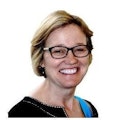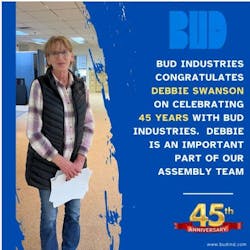How Do You Innovate When You’re Small, 96 Years Old and Make One Basic Thing?
In early childhood, like any good future executive, Josiah Haas already had decided on two dream careers for himself—a stretch goal and a solid choice. The stretch goal was to play third base for the Cleveland Indians. The solid was to become CEO of his family’s manufacturing business—Bud Industries, founded by his great-grandfather, Max “Bud” Haas, in 1928.
Josiah scrapped the baseball plan when the Little League pitches got faster, but the idea of running the family business persisted through high school as he worked summers doing different jobs at the plant. “Every day was different,” he said of those days at the Willoughby, Ohio, manufacturer of electronic enclosures. “I knew this was where I wanted to be.”
Josiah’s three brothers had little interest in doing the same. “None of us were pressured into working here—life is too short to do something you don’t want to do,” he said.
After college at Indiana University and a sales role at a Chicago enterprise software company, Josiah came home and cycled through lower-level leadership roles at Bud beginning in 2006. In 2015, he became president of the company.
Recently, I toured Bud’s operations and talked with employees in different roles at the plant. It was a crash course in how a small family manufacturer can keep meeting the moment, through four generations, while maintaining a culture where people feel appreciated and challenged.
Here’s what I learned:
Be versatile and keep innovating.
Bud’s first breakthrough innovation was the small antenna that fit on radios in the 1920s. It quickly caught on, as Americans were glued to their radio programs but weren’t so keen on having to install roof antennae to listen in.
As Bud’s antenna became more of a commodity than the latest thing, leadership moved into HAM radio equipment. When that craze ebbed, the Haases saw a market in making enclosures for increasingly sophisticated electronics, innovating through the birth of the hi-fi stereo in the 1950s, the space race of the 1960s, early personal computers in the 1970s and, more recently, semiconductors and cloud servers.
Currently, about 40% of Bud’s work is custom. The company also provides engineering support for customers. Machining varies and so do materials—steel, stainless steel and aluminum are machined in the U.S., plastics and fiberglass overseas. Heavier-gauge aluminum can withstand an earthquake. Specialized enclosures like cloud server racks can hold up to 1700 pounds and require ultra-smooth weld finishes to prevent cable snags.
“What’s going into our boxes changes daily,” said Josiah. “The boxes are still there to house the components, and the certifications that we provide are still needed. So it’s been good we’ve evolved.”
Fast-turnaround capabilities bring in government clients “that wait till the last minute to do stuff,” said Josiah. “Or they're waiting on budget approval. So we're able to work with them and supply the engineering and manufacturing resources to get them what they're looking for.”
Notable projects through the decades have included 11-foot custom racks for test equipment for the first space shuttles, enclosures for crash controls for missile systems and boxes for Wi-Fi systems in NFL stadiums. Bud has even made it to Hollywood, working with set designers to fashion racks for control rooms depicted in the movies “First Kid” and “Navy SEALs.”
Give your core people a variety of roles. Move them around and have them working with different people and teaching others.
A handful of “Half-Century Club" members with more than 50 years at Bud include CEO Blair Haas, Josiah’s father; welder Jim Brown, who’s retired but still comes in and sets his own hours and George Helsius, senior strategic project manager, who’s “a resource for just about every department,” said Josiah.
Helsius spent his first five years mastering every role on the shop floor, then considered leaving Bud for a new challenge.
“And the company said, ‘Well, since you’ve done all these jobs, you’re aware of not only the process, but the products that we’re producing’ and they offered me a job as an estimator,” Helsius said.
Bud provided training on the financial side of the job. “After that, I went from an estimator to a technical sales supervisor to traveling estimator,” said Helsius. “It just kind of snowballed. I really liked working with people, and I liked the mechanical portion of it, designing stuff.”
Debbie Swanson, a 45-year-employee, prefers working on the shop floor, where “every day is different,” and knows plant operations inside and out. She started in the shipping department when her daughter was two years old, then moved to building cabinets, then small assembly and packing.
Swanson is often asked to help with special projects and train other workers in the plant.
“She’s always willing to help people with their challenges,” said Josiah. “And she continues to learn.”
Build relationships with schools and manufacturing organizations.
When Bud struggled to find talent a few years back, leadership worked with local high schools to develop a work-study program that accommodated school and extracurricular schedules. Welding interns are trained on the job. The hope is that they stay after graduation, although that doesn’t always happen. Even if they don’t, Bud gains good workers for the internship period, creates goodwill in the community and adds more welders to the area’s labor pool, lifting all boats, so to speak.
Bud tapped another local resource—MAGNET, the local Manufacturing Extension Partnership—when it was planning for the major capital investment of a new powder coating line. MAGNET provided help with financing and planning, as well as choosing and coordinating nearby vendors that could repair equipment quickly. “They got started in the right direction,” said Josiah.
Once the powder line is up and running at the end of summer, the plan is to work with MAGNET again, on a next-gen training program.
Plan your big investments years ahead of time.
Purchase orders for the powder line and a robotic welder to keep pace with increased production were signed last November. But strategizing began long before, on not only how to pay for the $2.5-$3 million project but how to best configure it in the plant and minimize disruption while installing it.
“It’s a daunting project for a small family-owned business,” said Blair. “We’ve been thinking about doing this for years and years.”
The installation timeline is staggered to keep production running, and backup resources for powdering are lined up “because our customers will only let us go so long without shipping product,” said Blair. “They’ve been prepped since the first of the year that this is coming: Place orders early so we can get it out.”
A third project, to partially automate shipping, is on hold. “We want to make sure we onboard things correctly,” said Josiah. “If you run too many programs at the same time, it doesn’t allow you to allocate the resources because your director of manufacturing or supervisors may be involved in the multiple projects.”
Listen to your employees and help them out.
Bud gives tuition reimbursement for relevant college classes, and leadership encourages employees to let them know when they are struggling and will do what they can to help out. “That’s why I’ve stayed here as long as I have,” said Helsius.
“Years ago, my mother got sick, and I had to move her in with me. I was missing a great deal of work. And I had to babysit my two smaller sons.
“Blair basically said, ‘Look, you’ve only got one mom.’ And they changed everything around for me,” letting him take the time he needed, work a flexible schedule around the visiting nurse’s hours and even making accommodations for his two youngest sons when he needed childcare.
It’s never too late for a promotion.
Swanson was just promoted to assembly lead. She’ll be leading the transition to the new powder line, maneuvering people around the new work environment. She’ll also herself be training in digital printing, a newer technology at the plant to customize products with customers’ branding and logos.
“I think the fact that she’s well-respected by everyone, it made sense,” said Josiah. With some of the updates that are coming in, we needed an additional lead person in this area. Based on her background, and that she’s done it for so long and that she wants to keep working, we thought it was an interesting challenge for her.”
Swanson is taking her promotion in stride, just like she’s taken every day on the job. “They’ve been a family,” she said of her employers. “I’ve enjoyed working with them. I’ve worked with three generations of the Haases and I just enjoy my work. I really do. And following the technology changes, it’s inspiring to keep up with things and see all these different changes come through.”
About the Author

Laura Putre
Senior Editor, IndustryWeek
As senior editor, Laura Putre works with IndustryWeek's editorial contributors and reports on leadership and the automotive industry as they relate to manufacturing. She joined IndustryWeek in 2015 as a staff writer covering workforce issues.
Prior to IndustryWeek, Laura reported on the healthcare industry and covered local news. She was the editor of the Chicago Journal and a staff writer for Cleveland Scene. Her national bylines include The Guardian, Slate, Pacific-Standard and The Root.
Laura was a National Press Foundation fellow in 2022.
Got a story idea? Reach out to Laura at [email protected]


